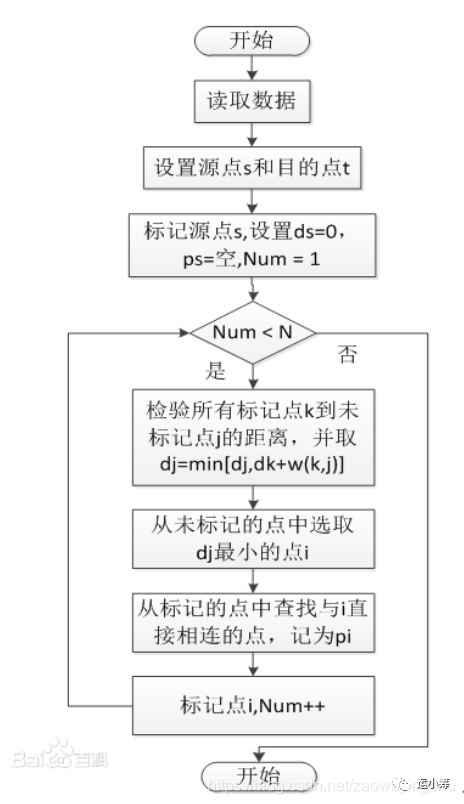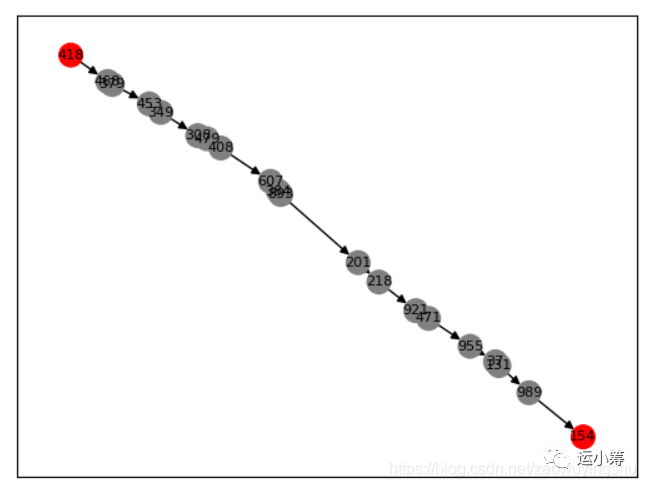前言
迪杰斯特拉算法(Dijkstra)是由荷兰计算机科学家狄克斯特拉于1959 年提出的,因此又叫狄克斯特拉算法。是从一个顶点到其余各顶点的最短路径算法,解决的是有权图中最短路径问题。迪杰斯特拉算法主要特点是从起始点开始,采用贪心算法的策略,每次遍历到始点距离最近且未访问过的顶点的邻接节点,直到扩展到终点为止。该算法在运筹学和数据结构图论部分都有介绍,是一种非常有效的求解单源最短路问题的算法
提示:以下是本篇文章正文内容,下面案例为Solomon标准算例
一、最短路模型
详见上期推文:优化|手把手教你用Python调用Gurobi求解最短路问题
二、迪杰斯特拉算法
原理如下,简单地说它的主要特点是以起始点为中心向外层层扩展(类似于广度优先搜索),将节点由T(temporary)不断更新为P(permanent),直到扩展到终点为止,最终通过回溯上一个节点的办法来得到最短路径。废话少说,直接上代码!
 copyright@baidu
copyright@baidu
二、python代码实现
代码如下:
案例中选择使用Solomon标准算例的1000个节点。随机设置起点和终点为418,154号node。
# _*_coding:utf-8 _*_
from __future__ import print_function
from __future__ import division, print_function
import re
import math
import matplotlib.pyplot as plt
import numpy as np
import pandas as pd
import copy
from matplotlib.lines import lineStyles
import time
import networkx as nx
starttime = time.time()
class Data():
'''
the format of solomon dataset
'''
def __init__(self):
self.customerNum = 0 # the number of customers
self.nodeNum = 0 # the sum of customers and depots
self.vehicleNum = 0
self.capacity = 0
self.cor_X = []
self.cor_Y = []
self.demand = []
self.readyTime = []
self.dueTime = []
self.serviceTime = []
self.disMatrix = {}
def read_data(self, path, customerNum, depotNum):
'''
function to read solomom data from .txt files, notice that it must be solomon dataset
INPUT
@ data : class Data
@ path : Data path
@ customerNum : the number of customer
OutPut : none
'''
self.customerNum = customerNum
self.nodeNum = customerNum + depotNum
f = open(path, 'r')
lines = f.readlines()
count = 0
for line in lines:
count = count + 1
if (count == 5):
line = line[:-1].strip()
str = re.split(r" +", line)
self.vehicleNum = int(str[0])
self.capacity = float(str[1])
elif (count >= 10 and count <= 10 + customerNum):
line = line[:-1]
str = re.split(r" +", line)
self.cor_X.append(float(str[2]))
self.cor_Y.append(float(str[3]))
self.demand.append(float(str[4]))
self.readyTime.append(float(str[5]))
self.dueTime.append(float(str[6]))
self.serviceTime.append(float(str[7]))
# compute the distance matrix
self.disMatrix = {}
for i in range(0, self.nodeNum):
dis_temp = {}
for j in range(0, self.nodeNum):
dis_temp[j] = int(math.hypot(self.cor_X[i] - self.cor_X[j], self.cor_Y[i] - self.cor_Y[j]))
self.disMatrix[i] = dis_temp
def plot_nodes(self):
'''
Description: function to plot
'''
Graph = nx.DiGraph()
nodes_name = [str(x) for x in list(range(self.nodeNum))]
Graph.add_nodes_from(nodes_name)
cor_xy = np.array([self.cor_X, self.cor_Y]).T.astype(int)
pos_location = {nodes_name[i]: x for i, x in enumerate(cor_xy)}
nodes_color_dict = ['r'] + ['gray'] * (self.nodeNum - 1)
nx.draw_networkx(Graph, pos_location, node_size=200, node_color=nodes_color_dict, labels=None,font_size =8)
plt.show()
def plot_route(self, route, color='k'):
Graph = nx.DiGraph()
nodes_name = [route[0]]
cor_xy = [[self.cor_X[route[0]], self.cor_Y[route[0]]]]
edge = []
edges = [[route[0],route[1]]]
for i in route[1:]:
nodes_name.append(i)
cor_xy.append([self.cor_X[i], self.cor_Y[i]])
edge.append(i)
if len(edge) == 2:
edges.append(copy.deepcopy(edge))
edge.pop(0)
Graph.add_nodes_from(nodes_name)
Graph.add_edges_from(edges)
pos_location = {nodes_name[i]: x for i, x in enumerate(cor_xy)}
nodes_color_dict = ['r'] + ['gray'] * (len(route)-2)+['r']
nx.draw_networkx(Graph, pos_location, node_size=180, node_color=nodes_color_dict, edge_color=color, labels=None,font_size =8)
plt.show()
# function to read data from .txt files
def readData(path, nodeNum):
nodeNum = nodeNum;
cor_X = []
cor_Y = []
f = open(path, 'r');
lines = f.readlines();
count = 0;
# read the info
for line in lines:
count = count + 1;
if (count >= 10 and count <= 10 + nodeNum):
line = line[:-1]
str = re.split(r" +", line)
cor_X.append(float(str[2]))
cor_Y.append(float(str[3]))
# compute the distance matrix
disMatrix = [([0] * nodeNum) for p in range(nodeNum)];
for i in range(0, nodeNum):for j in range(0, nodeNum):
temp = (cor_X[i] - cor_X[j]) ** 2 + (cor_Y[i] - cor_Y[j]) ** 2
disMatrix[i][j] = (int)(math.sqrt(temp))
temp = 0
return disMatrix
def printData(disMatrix):
print("-------cost matrix-------\n");
for i in range(len(disMatrix)):for j in range(len(disMatrix)):# print("%d %d" % (i, j));print("%6.1f" % (disMatrix[i][j]), end=" ");
# print(disMatrix[i][j], end = " ");
print()
def Dijkstra(Graph, org, des):
Q = list(Graph.nodes())
for node in Q:
if (node == org):
Graph.nodes[node]['min_dis'] = 0
else:
Graph.nodes[node]['min_dis'] = np.inf
current_node = org
while (len(Q) > 0):
min_dis = np.inf
for node in Q:
if (Graph.nodes[node]['min_dis'] current_node = node
min_dis = Graph.nodes[node]['min_dis']#找最小的距离的点
if (current_node != None):
Q.remove(current_node)
for child in Graph.successors(current_node):
arc = (current_node, child)
dis_temp = Graph.nodes[current_node]['min_dis'] + Graph.edges[arc]['length']
if (dis_temp 'min_dis'Graph.nodes[child][ 'min_dis'] = dis_temp
Graph.nodes[child][ 'previous_node'] = current_node
min_dis = Graph.nodes[des][ 'min_dis']
current_node =des
shortest_path = [current_node] while (current_node != org):
current_node = Graph.nodes[current_node][ 'previous_node']
shortest_path.insert( 0, current_node) return shortest_path, min_dis if __name__ == "__main__":
data = Data()
path1 = 'C:/Users/asus/Desktop/vrp/Solomn标准VRP算例/homberger_1000_customer_instances/R1_10_1.txt'
data.read_data(path=path1, customerNum= 1000, depotNum= 1) # change the path
nodeNum = 1000
cost = readData(path1, nodeNum)
Nodes=[]
Arcs ={} for i in range(nodeNum):
Nodes.append(i) for j in range(nodeNum): for i in range(nodeNum): if i != j:
Arcs[i, j] = cost[i][j]
Graph = nx.DiGraph() for node in Nodes:
Graph.add_node(node, min_dis= 0, previous_node=None) for key in Arcs.keys():
Graph.add_edge(key[ 0], key[ 1], length=Arcs[key])
org = 418
des = 154
shortest_path,min_dis=Dijkstra(Graph, org, des)
print(shortest_path)
print(min_dis)
data.plot_route(shortest_path)
data.plot_nodes()
结果展示
案例中的1000个点,我们选择起点为418,终点为154号。 最短路如下:
最短路如下: 结果如下
结果如下
作者:
王基光,清华大学,清华伯克利深圳学院(硕士在读)
刘兴禄,清华大学,清华伯克利深圳学院(博士在读)
往期精彩文章:
优化|手把手教你用Python调用Gurobi求解最短路问题
优化| 手把手教你用Java实现单纯形法
优化| 手把手教你用Python调用Gurobi求解VRPTW
优化 | 两阶段启发式算法求解带时间窗车辆路径问题(附Java代码)
Java调用cplex求解运输问题
编辑:
排版 | 徐璐,清华大学,清华-伯克利深圳学院(硕士在读)
审校 | 周鹏翔,清华大学,清华-伯克利深圳学院(博士在读)
感谢阅读!欢迎大家关注我们的公众号“运小筹”以及粉丝群!
因为微信扫码人数限制,现在扫码加主编微信,拉你进群,掌握运筹学前沿知识~
微信群:

QQ群:




















 2万+
2万+











 被折叠的 条评论
为什么被折叠?
被折叠的 条评论
为什么被折叠?








